Technique of skating on skis. Errors in the technique of skating
Skiing as a professional sport or amateur hobby, it began to gain its momentum again. Many cities already today can do more than one proposal for individual learning skiing or offer classes in groups with the same level of training for all students.
To learn the methods and technique of skiing on ski in various ways, including independently studied technique in theory and applying it to the tracks at various levels of complexity, from smallest to largest. At the moment, one of the relatively new and most useful is the technique of skating on skis. For information on how, where and who use this method of walking, you can see from this article.
What is it?
The emergence of skating in skiing - a relatively new phenomenon. In addition to this embodiment there are classic and free. Ridge course is characterized by the active participation of the legs during riding, which distinguishes it from the classical. A special feature of this technique is the repulsion of the ski at a certain angle from the road with respect to the direction of movement. Visually such a maneuver reminiscent of ice skating. In connection with this fact, and there was a name for this technique. There are several varieties of this riding. Technique ridge moves on skis may differ certain nuances performance depending on the route, the level of training kata person or convenience implementation of either option.
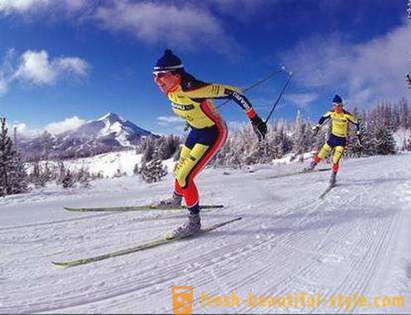
The emergence of a new method of skiing was due to progress in the field of ski equipment. The development of more modern skis, ski boots and improvement of fixing one to the other has allowed athletes and fans in this area to make a side stop on foot. This fact has contributed to the development of a new technique of cross-country skiing, which became longer use his legs and reduce the load on the arm as compared to the classic version. When using a method such as ridge course on skis, performance of equipment can have four varieties, and be used in different situations.
Where relevant, this technique?
Field of application of this method of riding on the tracks has changed significantly over the past few decades. The original meaning of skating was limited only to teach the exercises for the development of athletes cornering and other difficult sections of the route. After the invention of new elements of the ski outfits such a course has changed its meaning from the usual exercise equipment to separate, applicable both professional competitions, and on the slopes of amateur ski resorts.
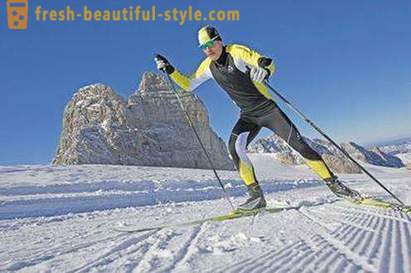
Technique of skating skiing is available in the application to any person who feels comfort and confidence in its implementation. A professional athlete can apply the elements of this method or some of its variants as part of the freestyle skiing competition at all, allowing this style movement in situations where it is convenient and it gives the advantage of speed. Individual professional competitions in a ridge technique does not currently exist.
With the passage of challenging trails and sites is particularly advantageous technique of skating on skis. Errors can arise when it is executed. It is therefore important to know about it and hone skills.
The History of
About a hundred years ago, skating course used as a regular training exercise for skiers and did not consider both individual technique. The reason for this situation was uncomfortable fixing the ski boot to the ski itself.
After the appearance of innovations in the equipment of the skier, which occurred in the 70-ies of XX century, this technique has become more convenient, and its application helps to develop greater speed of movement. We revised training program at competitions held in the next few decades. Technique of skating on skis began to have different embodiments.
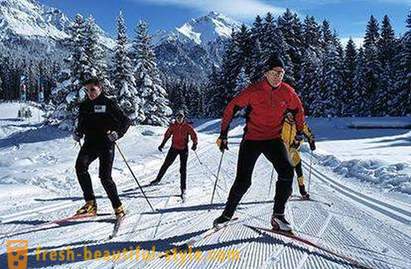
At the moment, this way of movement on the slopes or elements take place only in the free-style skiing. Skating stroke may be represented as odnoshazhnogo, dvuhshazhnogo, polukonkovogo or variable. Also in a separate version of the movement can be a technique without the use of poles, that is, almost without using his hands. Each of these options for specific routes and their elements. Combination of several subspecies of skating and alternating it with the classic on one track makes it possible to improve the efficiency of its passage.
In this regard, training in various techniques of skiing from early childhood gives good results in the future. For lovers of the use of several ski options make the process more interesting and exciting, but also contributes to the training of more muscles.
Rules of
Any skating course on skis, equipment performance which takes place without errors, must obey these rules:
- The need for involvement of inertia and its own weight, and not just physical strength.
- One leg is the support, the other - repellent.
- center of mass should always be positioned above the supporting leg.
- In the process of pushing away the center of mass is fed slightly forward with respect to the shoe supporting leg, then the body is aligned slightly rotated toward the direction repels foot.
- is required to select the length of the stick, which is calculated according to the formula for high efficiency involvement of its weight and inertia of the skier height minus 20 centimeters. Higher sticks do not allow you to effectively apply the above rules into practice.
Odnoshazhny course
Different types of equipment is of skating on skis. Simultaneous odnoshazhny course is one of them. Perform one complete cycle of such stroke includes two steps. They are executed as follows:
- initially occurs repulsion of one of the legs;
- simultaneously with repulsion repulsion occurs feet with both hands;
- after which a sliding pivot foot.
breaching of all these movements is considered to be performing one complete cycle progression. Skier in one minute can carry up to 50 such cycles. This requires high physical fitness.
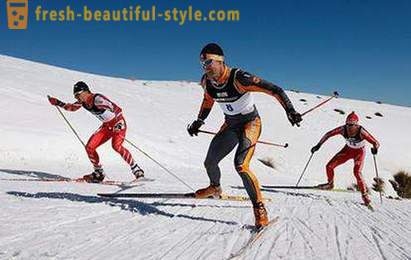
This technique of excellent for the development of high speed when moving up, on a flat part of the track, on the small sloping downhill. This course is an excellent option skier traffic in situations where you need to accelerate the speed or the acceleration of movement.
This technique of skating on skis up the hill every cycle helps to overcome a person of 4-10 meters. By moving the athlete on a flat part of the track, this number increases up to 6-15 meters, provided that this way of skiing is performed without error. By the time of jogging should not take more than one or two seconds. When skiing should also fulfill the basic rules of skating, which have already been outlined above.
Dvuhshazhny course
Various techniques of skating on skis. Dvuhshazhny simultaneous move - another one of its variants. Its implementation is a bit like the previous method. The only difference is that in this situation, both skis, and, respectively, and both legs are at a certain angle to the direction of motion of the skier. Execution of one cycle of such a move takes is still no more than one or two seconds. In one minute, a trained person can perform 30 to 70 such cycles.
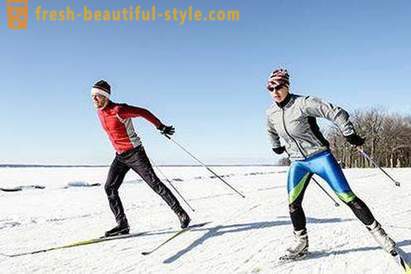
The complete cycle of the implementation of simultaneous dvuhshazhnogo course includes the commission of two sliding steps different feet and one hand repulsion, ie repulsion poles from the road. The use of such a move is useful when moving up on the hill a small or medium-coolness. Also, this method is often used when running on the flat parts of the route. Recently, equipment described ridge moves on skis has become the most popular and usable among athletes and among advanced amateurs. This option is rarely used when driving downhill, but occasionally used in such a situation it is appropriate.
The length of one full cycle, perform simultaneous dvushazhnym ridge course, can vary from 3, 5 to 8 and 5 meters. It's a bit smaller than the previous version of skiing, but significantly increases the number of cycles per one minute cross-country skiing. This fact could give the skier speed advantage, which is one of the reasons for the increased popularity of this subspecies ridge technology.
Alternately stroke
Also includes a technique of skating on skis alternate version of the movement on the slopes. This subspecies is significantly different from the previous two. Its peculiarity lies mainly in the following two sliding steps and has two successive repulsive arm movements. Due to this, and there is the name of art.
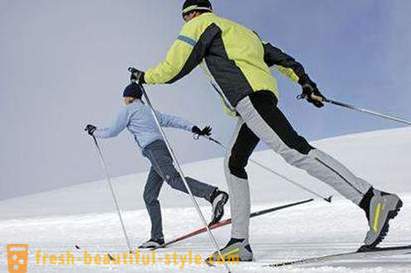
Due to perform hand-off after each step there is a reduction of the sliding velocity of movement relative to odnoshazhnomu and dvushazhnomu embodiments. The length of each such a move does not exceed 5 meters. A total phase alternating stroke takes a professional skier less than a second. Such a technique is used when climbing a steep hill. It is advisable to use alternate ridge course and not very good conditions for sliding, as well as soft piste. It is well-flex ski which softens the terrain irregularities and makes mistakes any equipment less noticeable. The use of these skis is typical for beginners or in the case of driving on the track with soft snow.
technique without using sticks
To maintain a high speed of movement or its development is another way of skating equipment skiing - skating without repulsion hands. He has two of its subspecies, both of which do not involve a stick. This technique is used in flat sections where good conditions for sliding, or on flat areas of the ski slopes. Visually, this option is even more reminiscent of the movement of the skater. Using sticks, ie repulsion hands in such a situation only slows the skier and does not allow for maximum movement speed.
In carrying out such a move only skier makes two sliding steps. At this time, his body is tilted at an angle which is about 45 degrees. This state of the body makes it possible to reduce the wind resistance of the counter.
Technique of skating on skis without poles divided into performing movements with moves without them. In the first embodiment, Mahi hands enable us to develop more speed. Skier performing active movements of the hands back and forth, combining them with footwork. Stick during such movements are at an angle and directed back rings.
In the second embodiment of the ski run without sticks hands folded in front of chest so as to press the stick to the body. They are in a horizontal position back rings, as in the previous embodiment. Often, skiers keep their armpits. This situation is characterized by lower energy consumption due to the passive operation of hands.
Polukonkovy course
Effective in the development of high speed and spread in the use of machinery is a subspecies of skating on skis - polukonkovy move. He has a number of differences from all previous versions of movement on snow track. Used mainly on the plain or flat parts for road ski skating. Often it is used in a downward motion, that is, on a small downhill slope. Perform one complete cycle takes less than one second from the skier. Often, during this time, you can do two full phase.
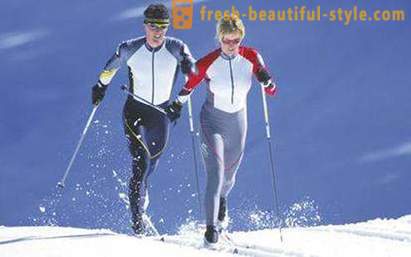
The cycle consists of a set of the following movements:
- The center of human body weight is initially in relation to the heel feet, which runs support, slightly behind and to the side. Further there is a sliding support leg.
- At the same time with the movement of the legs, which initially made support skier straightens up and puts his hands back.
- Next, the second leg performs swing up and away, sliding step is performed.
- At completion of the sliding step is almost straightened supporting leg is supposed to this technique of skating on skis - polukonkovy. At the same time put a stick in the snow further off after this. The body should lean forward slightly.
- Makhovaia leg, which should be slightly bent at the knee joint, perform lunges forward and slightly to the side, put the ski runs at a slight angle to the direction of motion of the skier.
- At this point, the heel should be skrestnye and the supporting leg - start to bend at the knee, ready to slip.
the supporting legs while performing one cycle are alternately left and right, and Makhov, respectively - left and right at this moment.
Exercises
For the development of all the above techniques need a systematic practice on the slopes, as well as regular classes with the performance of movements simulating running skier. It exists for such an option, as the technique of skating on skis, exercise. The most common and useful are the following movement and posture:
- Transfer the total weight from one foot to the other with alternate bending the legs at the knee joints. Hands will not be involved in this movement. They are behind.
- The same transfer of a support from one foot to the other. Arms extended forward. Sticks thus arranged perpendicular to the surface.
- In the flat track alternately performed free sliding step then right, then left foot. Two sliding steps - one repulsion hands.
- Performing alternately moving step is right, then the left foot, but with two repulsions sticks after each step.
- The alternate combination of all the techniques of skating on the flat track.
- Performing odnoshazhnogo progress with repulsion hands on the flat parts of the route.
All these exercises help to get used to the light the slopes as well as on medium difficulty routes. Correct to learn to keep your trunk and move the center of mass - one of the main problems in teaching skiing ridge any way.
Common Errors
Technique of skating on skis errors should minimize or eliminate altogether. Improper performance of this method of transportation can not provide the expected result or contribute to injury. Extremely dangerous mistakes in the technique of cross-country skiing on the slopes, curves or inclines. On level ground, and in the presence of soft ski athlete flaws become less noticeable.
Ridge technique becomes ineffective or their effectiveness is greatly reduced in the following cases:
- is too low bending forward when the sliding step does not occur the full load of his own body to ski;
- at too low a body inclination during repulsion may occur such reactions as the body turning sideways;
- statement supporting trails are not for themselves, but a little back also leads to a small loading door own weight.
There are other mistakes in the process of cross-country skiing ridge way, but they are all, in one way or another, linked to two factors. The first of them - is the low slope of the body, which, to everyone's belief, does not bring the speed of development. The inclination must not exceed 45 degrees. In such a case, the technique is effective. The second error - to find his feet at the time of repulsion under itself, and a little behind, that is, to the intersection with the vertical axis of the body. Both of these errors result either to drift in different directions, or to the partial load skiing own weight. For fast cross-country skiing you need to use, in addition to muscle mass, and even its own weight with the momentum. For lovers, skiers at the resort ski runs, the development of the maximum speed is sometimes not a priority, and so errors may seem not so rough. Skid torso to the side can result in loss of balance and fall, traumatic.
Technique of skating skiing performed on all of the above rules and procedures taking into account the errors can be accessed by both professionals and amateurs on the slopes of varying difficulty.













































